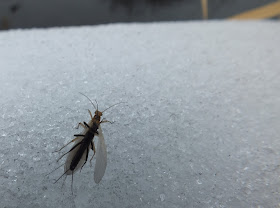We have all
heard that saying “spring is in the air”. And it certainly looks like spring is
finally here.
There is no
question that last week’s blizzard, and seasonally low temperatures through the
month of March have set things back a few weeks. But the melt has commenced and
signs of spring are everywhere. Longer days of course; but more importantly the
increased angle of the sun provides more solar energy – it just feels warmer.
We see the snow starting to disappear, puddles and slush abound, and the sounds
of trickling water are everywhere. That rhythmic drip, drip, drip is simply
music to our ears.
Above all
else however is the smell. Ahh the smell – it smells like…change. That
particular mix of earthy, musty, freshness that brings us out of our winter dormancy
and makes us want to get out and do stuff. It tells us that summer is close at
hand and it buoys our spirits in anticipation of things to come. These first
days of spring are a primordial cue that changes the way we act and feel.
These same cues
also drive behavior and “mood” in the aquatic realm. The life cycles of both trout
and bugs are intimately tied to the circle of the seasons. Knowing when to feed,
when to spawn, and when to hunker down are paramount to the success of any
species. To accomplish this, nature has developed a system of intricate indicators
to keep things on track; triggers and set-points that cue specific activities
at specific times of the year.
For the trout
and bugs, longer days and warmer temperatures form the basis of that spring has
sprung change in behavior – but it’s more than just that. Like us there is a
characteristic smell that solidifies the drive to shift gears. As the snow
starts to melt, run-off percolating through the surrounding topography injects
a characteristic chemical signature, a characteristic smell, into the water. Ahh
the smell – one can only wonder what the trout and bugs are thinking as the
water warms, the sediment stirs, and they also smell the coming of spring.
Early spring
is when things start to happen. Everything shifts from winter, dormant mode, to
get ready mode. Some bugs are already starting to hatch while others are simply
on the move. Mayfly nymphs are moving from deeper runs and holes to shallower
feeding areas that may be a few degrees warmer than the surrounding water –
exposing them to feeding trout. Trout that spawn in the spring are gorging on
the final influx of food while they wait for tributaries to swell to make their
trek upstream to spawn. While fall spawners are fully focused on taking
advantage of the smorgasbord that the spring freshets provide.
Spring is
also in the water.
 |
Tiny
Baetis nymphs are usually the first to make their move to shallow water.
They
will also be among the first bugs to emerge in the spring.
|







